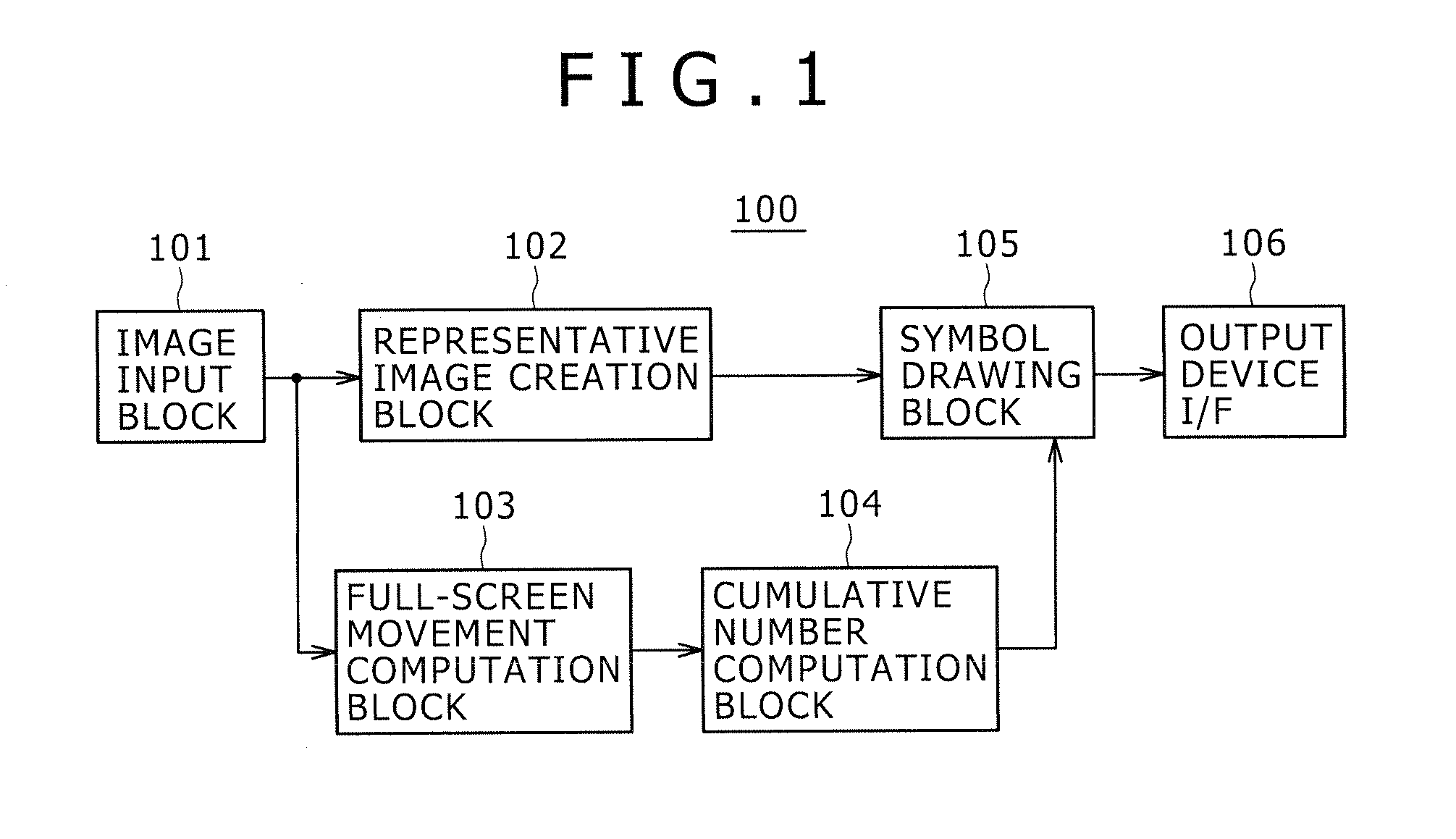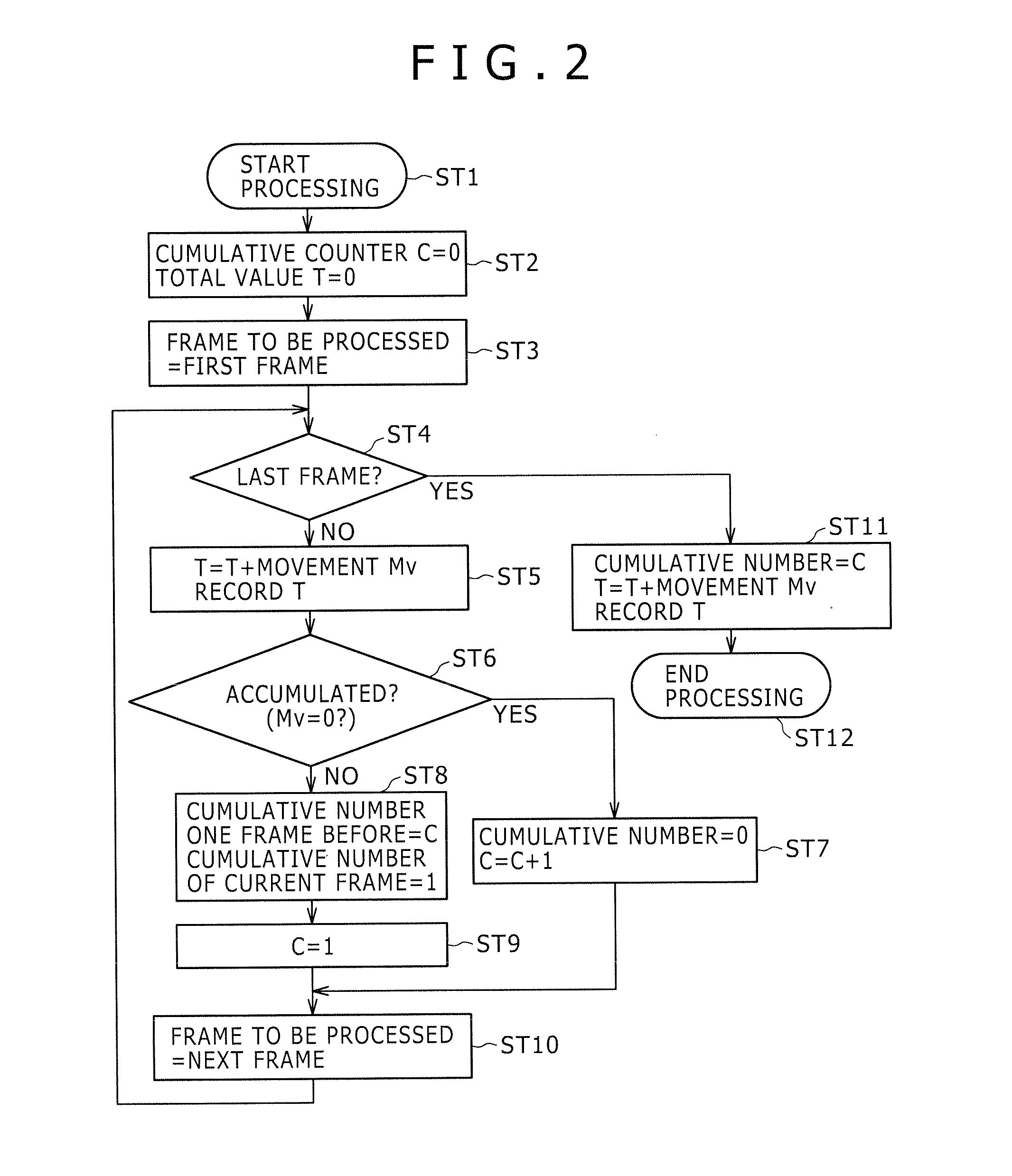Image processing apparatus and image processing method
- Summary
- Abstract
- Description
- Claims
- Application Information
AI Technical Summary
Benefits of technology
Problems solved by technology
Method used
Image
Examples
first embodiment
1. First embodiment
Exemplary Configuration of Image Processing Apparatus
[0070]Now, referring to FIG. 1, there is shown an exemplary configuration of an image processing apparatus 100 that is practiced as the first embodiment of the present invention. This image processing apparatus 100 has an image input block 101, a representative image creation block 102, a full-screen movement computation block 103, a cumulative number computation block 104, a symbol drawing block 105, and an output device interface (I / F) 106.
[0071]The image input block 101 inputs an image signal to be processed into the image processing apparatus 100. This image signal to be processed, obtained by taking a subject with an imaging device (a camera, for example), is directly supplied from the imaging device or read from a predetermined recording media to be supplied. In addition, this image input block 101 detects a scene change point by processing the inputted image signal, divides the inputted signal by scene, a...
second embodiment
2. Second Embodiment
Exemplary Configuration of Image Processing Apparatus
[0147]Referring to FIG. 16, there is shown an exemplary configuration of an image processing apparatus 100B practiced as the second embodiment of the invention. The image processing apparatus 100B has an image input block 101, a representative image creation block 102, a full-screen movement computation block 103, a cumulative number computation block 104, a symbol drawing block 105B, an output device interface I / F 106, and a thin-out number computation block 108. With reference to FIG. 16, components similar to those previously described in FIG. 1 are denoted by the same reference numerals and detail description thereof is skipped.
[0148]For example, the distance d between the symbols that are closest to each other in the display area is computed to determine the proximity between the symbols on the basis of the obtained distance d. The distance d is computed by equation (1) below by use of the length S in the ...
third embodiment
3. Third Embodiment
Exemplary Configuration of Image Processing Apparatus
[0175]Referring to FIG. 25, there is shown an exemplary configuration of an image processing apparatus 100A practiced as the third embodiment of the invention. The image processing apparatus 100A has an image input block 101, a representative image creation block 102, a full-screen movement computation block 103, a cumulative number computation block 104, a symbol drawing block 105A, an output device interface (I / F) 106, and a uniform velocity number computation block 107. Referring to FIG. 25, components similar to those previously described with reference to FIG. 1 are denoted by the same reference numerals and detailed description thereof is appropriately skipped.
[0176]The image input block 101 inputs an image signal to be processed into the image processing apparatus 100A. This image signal to be processed is obtained by taking a subject with an imaging device (a camera) for example and supplied directly fro...
PUM
 Login to View More
Login to View More Abstract
Description
Claims
Application Information
 Login to View More
Login to View More - R&D
- Intellectual Property
- Life Sciences
- Materials
- Tech Scout
- Unparalleled Data Quality
- Higher Quality Content
- 60% Fewer Hallucinations
Browse by: Latest US Patents, China's latest patents, Technical Efficacy Thesaurus, Application Domain, Technology Topic, Popular Technical Reports.
© 2025 PatSnap. All rights reserved.Legal|Privacy policy|Modern Slavery Act Transparency Statement|Sitemap|About US| Contact US: help@patsnap.com



